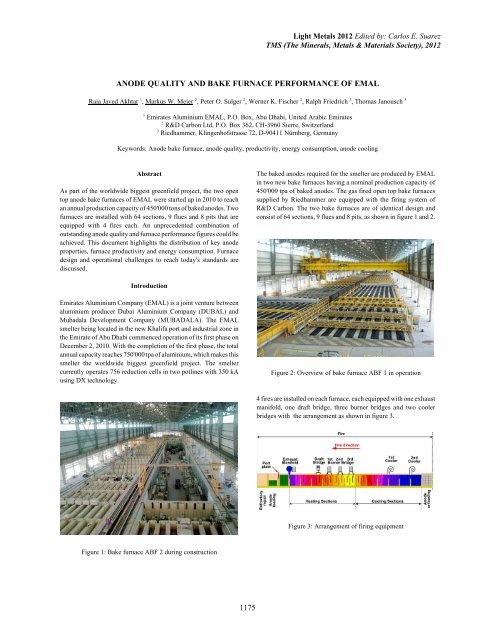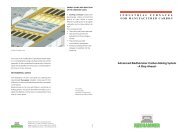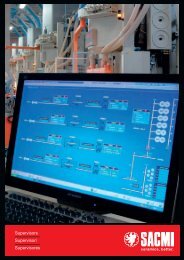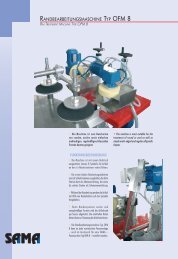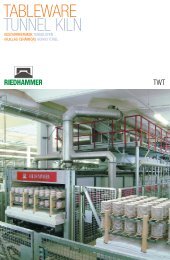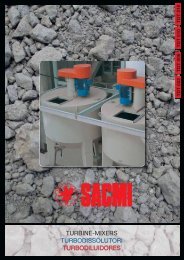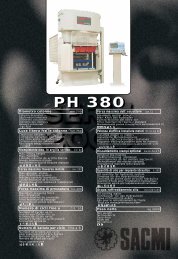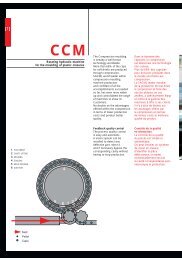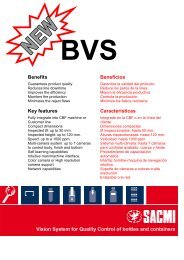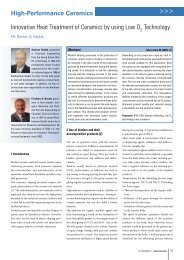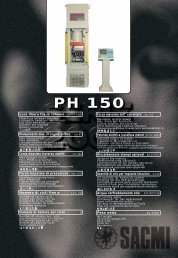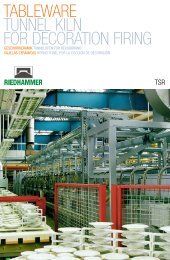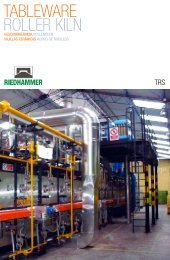Anode Quality and Bake Furnace Performance of EMAL - Riedhammer
Anode Quality and Bake Furnace Performance of EMAL - Riedhammer
Anode Quality and Bake Furnace Performance of EMAL - Riedhammer
Create successful ePaper yourself
Turn your PDF publications into a flip-book with our unique Google optimized e-Paper software.
Light Metals 2012 Edited by: Carlos E. Suarez<br />
TMS (The Minerals, Metals & Materials Society), 2012<br />
ANODE QUALITY AND BAKE FURNACE PERFORMANCE OF <strong>EMAL</strong><br />
Raja Javed Akhtar 1 , Markus W. Meier 2 , Peter O. Sulger 2 , Werner K. Fischer 2 , Ralph Friedrich 3 , Thomas Janousch 3<br />
1 Emirates Aluminium <strong>EMAL</strong>, P.O. Box, Abu Dhabi, United Arabic Emirates<br />
2<br />
R&D Carbon Ltd, P.O. Box 362, CH-3960 Sierre, Switzerl<strong>and</strong><br />
3 <strong>Riedhammer</strong>, Klingenh<strong>of</strong>strasse 72, D-90411 Nürnberg, Germany<br />
Keywords: <strong>Anode</strong> bake furnace, anode quality, productivity, energy consumption, anode cooling<br />
Abstract<br />
As part <strong>of</strong> the worldwide biggest greenfield project, the two open<br />
top anode bake furnaces <strong>of</strong> <strong>EMAL</strong> were started up in 2010 to reach<br />
an annual production capacity <strong>of</strong> 450'000 tons <strong>of</strong> baked anodes. Two<br />
furnaces are installed with 64 sections, 9 flues <strong>and</strong> 8 pits that are<br />
equipped with 4 fires each. An unprecedented combination <strong>of</strong><br />
outst<strong>and</strong>ing anode quality <strong>and</strong> furnace performance figures could be<br />
achieved. This document highlights the distribution <strong>of</strong> key anode<br />
properties, furnace productivity <strong>and</strong> energy consumption. <strong>Furnace</strong><br />
design <strong>and</strong> operational challenges to reach today's st<strong>and</strong>ards are<br />
discussed.<br />
The baked anodes required for the smelter are produced by <strong>EMAL</strong><br />
in two new bake furnaces having a nominal production capacity <strong>of</strong><br />
450'000 tpa <strong>of</strong> baked anodes. The gas fired open top bake furnaces<br />
supplied by <strong>Riedhammer</strong> are equipped with the firing system <strong>of</strong><br />
R&D Carbon. The two bake furnaces are <strong>of</strong> identical design <strong>and</strong><br />
consist <strong>of</strong> 64 sections, 9 flues <strong>and</strong> 8 pits, as shown in figure 1 <strong>and</strong> 2.<br />
Introduction<br />
Emirates Aluminium Company (<strong>EMAL</strong>) is a joint venture between<br />
aluminium producer Dubai Aluminium Company (DUBAL) <strong>and</strong><br />
Mubadala Development Company (MUBADALA). The <strong>EMAL</strong><br />
smelter being located in the new Khalifa port <strong>and</strong> industrial zone in<br />
the Emirate <strong>of</strong> Abu Dhabi commenced operation <strong>of</strong> its first phase on<br />
December 2, 2010. With the completion <strong>of</strong> the first phase, the total<br />
annual capacity reaches 750'000 tpa <strong>of</strong> aluminium, which makes this<br />
smelter the worldwide biggest greenfield project. The smelter<br />
currently operates 756 reduction cells in two potlines with 350 kA<br />
using DX technology.<br />
Figure 2: Overview <strong>of</strong> bake furnace ABF 1 in operation<br />
4 fires are installed on each furnace, each equipped with one exhaust<br />
manifold, one draft bridge, three burner bridges <strong>and</strong> two cooler<br />
bridges with the arrangement as shown in figure 3.<br />
Figure 3: Arrangement <strong>of</strong> firing equipment<br />
Figure 1: <strong>Bake</strong> furnace ABF 2 during construction<br />
1175
The pits are designed to hold 3 layers <strong>of</strong> 7 anodes each with a green<br />
<strong>and</strong> baked weight <strong>of</strong> 1'155 <strong>and</strong> 1'100 kg respectively. To reach the<br />
required production capacity, the furnaces are designed to operate<br />
with a fire cycle between 26.7 <strong>and</strong> 29 h. The resulting productivity<br />
per pit reaches 865 kg/h (ie. 21 anodes x 1'100 kg / 26.7 h).<br />
Considering the typical pit productivity level <strong>of</strong> other furnaces <strong>of</strong><br />
750 kg/h, the actual productivity <strong>of</strong> the <strong>EMAL</strong> furnaces is very<br />
elevated.<br />
In order to h<strong>and</strong>le a specific pit productivity at this level, it is<br />
m<strong>and</strong>atory to already prepare the ground at the design stage <strong>of</strong> both<br />
the bake furnace <strong>and</strong> the firing system.<br />
In particular, the following challenges are faced with an increased<br />
specific pit productivity level:<br />
S Homogeneous pit temperature distribution at all stages <strong>of</strong> baking<br />
to achieve uniform anode quality [1]<br />
S Control <strong>of</strong> the pitch burn enabling complete combustion <strong>of</strong> all<br />
pitch volatiles to minimize energy consumption <strong>and</strong> emissions<br />
[2]<br />
S Control <strong>of</strong> cooling process to maximize cooling efficiency <strong>and</strong><br />
minimize packing coke consumption<br />
Numerous design features were implemented in both furnace <strong>and</strong><br />
firing system to h<strong>and</strong>le the mentioned challenges. For thermal <strong>and</strong><br />
fluid dynamic aspects CFD modelling was utilized [3]. The<br />
experience <strong>of</strong> more than 40 years <strong>of</strong> R&D projects was the basis to<br />
underst<strong>and</strong> the link between the anode raw materials characteristics,<br />
the production parameters <strong>and</strong> the resulting baked anode quality [4,<br />
5, 6]. This knowledge allowed to utilize the flexibility <strong>of</strong> the firing<br />
system to choose material specific baking conditions with the<br />
optimal baking curve being adapted to the raw material <strong>and</strong> green<br />
anode properties.<br />
The challenges faced during the project <strong>and</strong> the achieved results are<br />
presented in this document.<br />
Temperature Distribution <strong>and</strong> <strong>Anode</strong> <strong>Quality</strong><br />
A principal requirement <strong>of</strong> anode baking is that all anodes<br />
independent <strong>of</strong> their location are subjected to the same heat<br />
treatment with uniform temperature distribution at all times.<br />
To quantify the temperature distribution within selected pits <strong>of</strong> a<br />
particular section, an Lc test was conducted. Graphite crucibles<br />
filled with green coke were placed in the two outer stub holes <strong>of</strong> all<br />
anodes in different sections <strong>of</strong> ABF 1 operated with a fire cycle <strong>of</strong><br />
28 h. After baking the graphite crucibles were removed from the<br />
unloaded anodes <strong>and</strong> the Lc <strong>of</strong> the baked (formerly green) coke was<br />
measured. Based on the calibration made with 20 hours soaking time<br />
at the maximum temperature, the relationship between the crystallite<br />
size Lc <strong>and</strong> the real temperature is known.<br />
Figure 4: Real pit temperature distribution in o C<br />
The figure 4 shows the real temperature distribution <strong>of</strong> a typical pit<br />
based on the Lc values. The temperature distribution <strong>of</strong> all measured<br />
pits (avg T +/- 2σ = 1'102 +/- 27 o C) is splendid <strong>and</strong> representative<br />
for the entire bake furnace, as 126 values were considered.<br />
Even though the Lc test was conducted during routine operation, it<br />
remains a snap-shot test. The routine anode quality control is<br />
inevitable to quantify the long term evolution. To evaluate the<br />
baking process, the properties influenced by the final temperature<br />
<strong>and</strong> heat-up rate may be considered by excluding any variations<br />
from the raw material quality <strong>and</strong> paste plant operation:<br />
S<br />
S<br />
S<br />
S<br />
S<br />
S<br />
S<br />
Real density<br />
Crystallite size Lc<br />
Specific electrical resistance<br />
Thermal conductivity<br />
Flexural strength<br />
CO 2 reactivity<br />
Air reactivity<br />
For illustrative purposes the evolution <strong>of</strong> selected anode properties<br />
are shown in figures 5 to 7. The red lines indicate upper <strong>and</strong>/or<br />
lower limits.<br />
The temporary drifts <strong>of</strong> the specific electrical resistance ( see figure<br />
5) are caused by raw material variations. The consistent figures <strong>of</strong><br />
the real density indicate a very uniform final baking temperature.<br />
1176
2.100<br />
2.090<br />
2.080<br />
Real Density [kg/dm 3 ]<br />
The high level <strong>of</strong> the flexural strength gives an indication that the<br />
heat-up rate is well under control. Although the air permeability is<br />
not primarily influenced by the baking process, its very low <strong>and</strong><br />
consistent level further confirm the excellent anode quality.<br />
2.070<br />
2.060<br />
16.0<br />
Flexural Strength [MPa]<br />
2.050<br />
58<br />
Jan-11 Feb-11 Mar-11 Apr-11 May-11 Jun-11 Jul-11 Aug-11<br />
Specific Electrical Resistance [micro Ohm m]<br />
14.0<br />
12.0<br />
10.0<br />
8.0<br />
57<br />
56<br />
6.0<br />
Jan-11 Feb-11 Mar-11 Apr-11 May-11 Jun-11 Jul-11 Aug-11<br />
55<br />
54<br />
53<br />
Jan-11 Feb-11 Mar-11 Apr-11 May-11 Jun-11 Jul-11 Aug-11<br />
2.0<br />
1.6<br />
Air Permeability [nPm]<br />
1.2<br />
Figure 5: Real density <strong>and</strong> specific electrical resistance<br />
0.8<br />
0.4<br />
The variations <strong>and</strong> in particular the sharp increase <strong>of</strong> the air<br />
reactivity residue in July <strong>and</strong> August 2011 are caused by variations<br />
<strong>of</strong> the vanadium content in the petroleum coke. The constant CO 2<br />
reactivity residue at high level confirm the optimized baking<br />
process.<br />
0.0<br />
Jan-11 Feb-11 Mar-11 Apr-11 May-11 Jun-11 Jul-11 Aug-11<br />
Figure 7: Flexural strength <strong>and</strong> air permeability<br />
100<br />
96<br />
92<br />
88<br />
84<br />
80<br />
CO 2 Reactivity Residue [%]<br />
Jan-11 Feb-11 Mar-11 Apr-11 May-11 Jun-11 Jul-11 Aug-11<br />
It can be concluded from the figures 5 to 7 that the baking process<br />
greatly contributes to the high <strong>and</strong> uniform anode quality.<br />
The findings from the routine quality control are confirmed by the<br />
exceptional performance <strong>of</strong> the anodes in the pots. The graphs in<br />
figure 8 show the evolution <strong>of</strong> key pot performance figures in 2011.<br />
90<br />
86<br />
Air Reactivity Residue [%]<br />
82<br />
78<br />
74<br />
70<br />
Jan-11 Feb-11 Mar-11 Apr-11 May-11 Jun-11 Jul-11 Aug-11<br />
Figure 6: CO 2 <strong>and</strong> air reactivity residue<br />
1177
360<br />
356<br />
352<br />
348<br />
344<br />
340<br />
100<br />
98<br />
96<br />
94<br />
92<br />
90<br />
450<br />
440<br />
Line Current in Potlines [kA]<br />
Jan-11 Feb-11 Mar-11 Apr-11 May-11 Jun-11 Jul-11 Aug-11 Sep-11<br />
Current Efficiency in Potlines [%]<br />
Jan-11 Feb-11 Mar-11 Apr-11 May-11 Jun-11 Jul-11 Aug-11 Sep-11<br />
Net Carbon Consumption [kgC/tAl]<br />
firing system have been designed <strong>and</strong> constructed to minimize the<br />
gas flow resistance in the flues <strong>and</strong> in the exhaust manifold<br />
respectively. Extensive CFD modelling was an important instrument<br />
for both the bake furnace <strong>and</strong> all components <strong>of</strong> the firing system.<br />
It has been reported earlier that minimizing the energy consumption<br />
should not be a primary goal <strong>of</strong> baking [2]. It is rather a resultant <strong>of</strong><br />
the primary goals <strong>of</strong> anode baking, such as the anode quality.<br />
By taking into account the raw material <strong>and</strong> green anode<br />
characteristics, the baking curve was adapted <strong>and</strong> optimized to the<br />
correct level. It is a principal goal to provide just as much energy as<br />
needed <strong>and</strong> to avoid overbaking <strong>of</strong> the anodes. The influence <strong>of</strong> the<br />
final baking temperature on the energy consumption was<br />
investigated in [3]: Increasing the baking temperature by 50 o C (5%)<br />
increases the energy consumption by about 10 % or approximately<br />
0.2 GJ/t <strong>of</strong> anodes.<br />
As a consequence <strong>of</strong> all described measures, the specific natural gas<br />
consumption was calculated to be 1.69 GJ/t <strong>of</strong> anodes for ABF 1<br />
operated with a fire cycle <strong>of</strong> 29 h <strong>and</strong> 1.55 GJ/t <strong>of</strong> anodes for ABF<br />
2 operated with 27 h. The low energy consumption, visually<br />
smoke-free VCM combustion (see figure 9) <strong>and</strong> extremely low<br />
emission figures confirm the high overall combustion efficiency.<br />
430<br />
420<br />
410<br />
400<br />
Jan-11 Feb-11 Mar-11 Apr-11 May-11 Jun-11 Jul-11 Aug-11<br />
2.5<br />
2.0<br />
<strong>Anode</strong> Problems [%]<br />
1.5<br />
1.0<br />
0.5<br />
0.0<br />
Jan-11 Feb-11 Mar-11 Apr-11 May-11 Jun-11 Jul-11 Aug-11<br />
Figure 8: Evolution <strong>of</strong> key pot performance figures<br />
Control <strong>of</strong> Pitch Burn <strong>and</strong> Energy Consumption<br />
Figure 9: Volatile matter combustion<br />
In order to fully burn the pitch fumes <strong>and</strong> hence utilize its<br />
combustion heat to minimize the overall energy consumption, it is<br />
vital to provide sufficient oxygen to the de-gassing zone. The energy<br />
consumption is further decreased by increasing the amount <strong>of</strong><br />
preheated air from the cooling sections. The bake furnace <strong>and</strong> the<br />
1178
<strong>Anode</strong> Cooling <strong>and</strong> Packing Coke Consumption<br />
To cope with the high pit productivity <strong>of</strong> 865 kg/h, efficient anode<br />
cooling becomes vital to avoid airburn attack <strong>and</strong> to allow safe<br />
anode unloading <strong>and</strong> h<strong>and</strong>ling.<br />
Insufficient anode cooling can result from:<br />
S<br />
S<br />
S<br />
Insufficient amount <strong>of</strong> cooling air<br />
Too coarse grain size distribution <strong>of</strong> packing material<br />
Excessive cooling air pressure<br />
Excessive cooling air pressure <strong>and</strong> too coarse packing material ignite<br />
the packing material, which leads to dramatic effects:<br />
S<br />
S<br />
S<br />
Increase <strong>of</strong> packing material consumption from less than 10 kg/t<br />
anodes to more than 30 kg/t anodes<br />
Insufficient anode cooling or even re-heating <strong>of</strong> the anodes<br />
<strong>Anode</strong> surfaces attacked by airburn<br />
Therefore the cooling efficiency is optimized by maximizing the<br />
amount <strong>and</strong> pressure <strong>of</strong> cooling air without igniting the packing<br />
material that should exhibit an optimum grain size distribution.<br />
The amount <strong>of</strong> cooling air <strong>and</strong> accordingly the cooling energy can<br />
be calculated by determining the airflow at all openings <strong>of</strong> the<br />
cooling sections based on measurements <strong>of</strong> the temperature, velocity<br />
<strong>and</strong> pressure. Measurements during routine operation <strong>of</strong> <strong>EMAL</strong> have<br />
revealed an average cooling energy <strong>of</strong> 880 MJ/t anodes, which is a<br />
very high level as the typical cooling energy observed in similar<br />
bake furnaces is between 700 <strong>and</strong> 850 MJ/t anodes.<br />
2.0<br />
The figure 10 illustrates the importance <strong>of</strong> avoiding packing coke<br />
ignition. Petroleum coke has a calorific value <strong>of</strong> 30 MJ/kg. When the<br />
packing coke consumption exceeds 30 kg/t anodes, its combustion<br />
energy completely eliminates the cooling effect.<br />
By respecting all mentioned requirements <strong>and</strong> optimizing all cooling<br />
processing parameters, <strong>EMAL</strong> is capable <strong>of</strong> maintaining a packing<br />
coke consumption <strong>of</strong> 9 kg/t anodes.<br />
Conclusions<br />
The collaboration <strong>of</strong> <strong>EMAL</strong> with pr<strong>of</strong>essional partners has lead to<br />
today's outst<strong>and</strong>ing performance <strong>of</strong> the anode bake furnaces:<br />
S 450'000 tpa <strong>of</strong> anodes are produced in today's biggest single site<br />
greenfield furnace with a combination <strong>of</strong> proven technology <strong>and</strong><br />
optimized key features on bake furnace <strong>and</strong> firing system.<br />
S An excellent <strong>and</strong> most uniform anode quality is produced that is<br />
monitored by the laboratory <strong>and</strong> confirmed by the pot room<br />
operation resulting in exceptional pot performance figures.<br />
S The combination <strong>of</strong> high anode quality with minimal variations,<br />
high pit productivity <strong>of</strong> 865 kg/h <strong>and</strong> energy consumption as low<br />
as 1.55 GJ/t sets a new benchmark.<br />
These performance figures are the result <strong>of</strong> pr<strong>of</strong>ound research<br />
activities <strong>and</strong> product development combined with the close<br />
collaboration <strong>of</strong> the involved partners.<br />
References<br />
Energy [GJ/tA]<br />
1.5<br />
1.0<br />
0.5<br />
Combustion energy <strong>of</strong> packing coke<br />
Cooling energy (air) 0.85<br />
0.70<br />
[1] Markus Meier, “Influence <strong>of</strong> <strong>Anode</strong> Baking Process on Smelter<br />
<strong>Performance</strong>”, Aluminium 1-2 2010<br />
[2] Felix Keller, Peter Sulger, Markus Meier, Dagoberto Severo,<br />
V<strong>and</strong>erlei Gusberti, “Specific Energy Consumption in <strong>Anode</strong><br />
<strong>Bake</strong> <strong>Furnace</strong>s”, Light Metals 2010, 1005 - 1010<br />
0.0<br />
0 10 20 30 40<br />
Packing coke consumption [kg/tA]<br />
Figure 10: Influence <strong>of</strong> packing coke consumption<br />
on anode cooling<br />
The optimum grain size distribution <strong>of</strong> the packing material is<br />
reached with minimum air flow through the packing material. Tests<br />
conducted by R&D Carbon have revealed that this requirement is<br />
mostly fulfilled with material smaller than 2 mm. Accordingly, raw<br />
coke that is not screened should not directly be added to the furnace.<br />
Coarse coke should be added only in well controlled conditions with<br />
homogeneous blending <strong>of</strong> the existing packing material.<br />
[3] Dagoberto Severo, Peter Sulger, Felix Keller, Markus Meier,<br />
“Recent Developments in <strong>Anode</strong> Baking <strong>Furnace</strong> Design”, Light<br />
Metals 2011, 853 - 858<br />
[4] Felix Keller <strong>and</strong> Peter Sulger, <strong>Anode</strong> Baking, Sierre,<br />
Switzerl<strong>and</strong>, R&D Carbon Ltd. 2008<br />
[5] Werner Fischer, Raymond Perruchoud, Markus Meier et al,<br />
<strong>Anode</strong>s for the Aluminium Industry, Sierre, Switzerl<strong>and</strong>, R&D<br />
Carbon Ltd. 1995<br />
[6] Werner Fischer, Raymond Perruchoud, Markus Meier et al,<br />
<strong>Anode</strong>s for the Aluminium Industry 1995 - 2005, Sierre,<br />
Switzerl<strong>and</strong>, R&D Carbon Ltd. 2005<br />
1179


